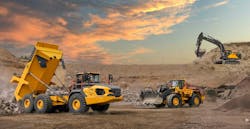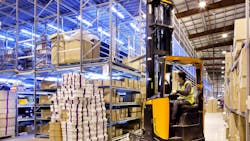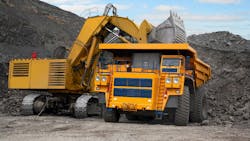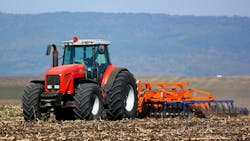Recovery and Long-Term Growth Predicted for Off-Highway Equipment Market
What you’ll learn:
- Why the off-highway equipment market will not experience a recovery until 2026.
- How global population growth will drive future equipment market demand.
- The short-term impacts tariffs are having on sales of agricultural machinery and other heavy equipment.
Market recovery is expected for the global off-highway equipment sector in 2026, followed by long-term growth in the coming years according to new insights from market intelligence firm Interact Analysis.
High interest rates and inventory levels were among the factors which challenged construction, agriculture and other off-highway markets in 2024. Both were expected to begin normalizing in 2025, bringing improved conditions for equipment manufacturers and their suppliers – including those in the fluid power industry.
However, tariffs put in place by the Trump administration have brought uncertainty to the market due in part to their continually changing nature. As Ken Baker, CEO of Bailey, told Power & Motion when tariffs were first implemented at the start of 2025, “The speed with which these tariffs were implemented has left us uncertain about how to proceed.”
The tariff situation has changed several times since then regarding how much they will be, what products and countries will be impacted, as well as when, or if, they will go into effect. At the time of publishing this piece, August 1 is the announced date for tariff implementation.
Despite the current uncertainty tariffs and other economic factors are creating for the global off-highway equipment market, Interact Analysis is projecting a sales recovery in 2026. A strong growth trajectory is anticipated in the coming years as well driven by three megatrends:
- labor shortages
- infrastructure demand and
- feeding an expanding global population.
Population Growth to Drive Future Off-Highway Equipment Demand
Although the global off-highway equipment industry will struggle through the rest of 2025, better market conditions are expected in the years to come. Interact Analysis is currently projecting sales for off-highway equipment will exceed 8 million units per year by 2035.
Continued population growth will be a key contributor to future off-highway equipment demand as it is driving infrastructure investments and the need for increased food production.
Governments around the world are funding the building of roads, bridges, renewable energy and other infrastructure, as well as their repair, to help improve transport of goods and the overall wellbeing of their populations.
Excavators, wheel loaders and other heavy equipment are utilized for these infrastructure projects, and therefore the global construction equipment market will benefit from these investments.
Volvo Construction Equipment’s second-quarter (Q2) 2025 results demonstrate the impact some of these investments are having on machinery sales. The company said the total machine market grew in Q2 compared to the previous year; the Chinese market was a key driver for this, increasing 26%, due to government policies stimulating the real estate sector in the region which drove demand primarily for smaller machinery. Improved market conditions in South America also benefited Volvo’s second quarter sales.
A new report from Business Market Insights forecasts the heavy construction equipment market will grow 51% by 2031 due in part to global infrastructure investments. According to the report, developing countries such as India, Mexico and Brazil are among those making such investments; China and the U.S. are also heavily investing in infrastructure.
Much of the investments being made in these and other parts of the world is due to the ever-increasing global population. Business Market Insights cites data from the World Bank that over U.S. $3.7 trillion will need to be invested each year into infrastructure developments to meet the needs of a growing global population. More people means there is also a need for more transportation options, housing, and energy production — all of which will require the use of various types of construction equipment to be built.
With this rise in global population also comes the need to feed it, an aspect which will benefit the agricultural equipment industry. It will be necessary to use tractors, combines and other farm machinery to plant and harvest crops of various types, leading to demand for such machines.
Many regions around the world are also in the process of mechanizing their farming operations which will further aid future demand for agricultural equipment.
Construction equipment and agricultural machinery are two of the largest customer markets for the fluid power industry. As such, increased demand for these machines in the coming years is likely to also benefit those developing the hydraulics, pneumatics and other components utilized within them.
Mining and Material Handling to Benefit from Goods Spending
Continued population growth brings with it increased demand for various goods, requiring extraction of materials for and movement of these goods. The mining machinery and material handling equipment used for these purposes will therefore also see increased demand in the future.
Rising consumer spending over the past several years has already benefited the material handling sector by increasing the construction of logistics and warehouse facilities and thus the equipment used to move goods within them such as forklifts and gantry cranes. As more of them have been built — and will continue to be — demand for this equipment will continue to increase, benefiting manufacturers of it as well as their various component suppliers, including many in the fluid power industry.
A number of goods, particularly electronics, are comprised of materials such as lithium and nickel which need to be extracted from the earth, necessitating use of various mining machinery to do so.
Demand for mined materials will only continue to rise as the global population grows and therefore requires more goods using these materials. In addition, rising adoption of electric vehicles, including in the off-highway space, will drive the need for mined materials as they are utilized in the batteries and electric motors used to power these vehicles.
With this continued demand will come the need for more mining equipment and the systems which power it.
Automation is likely to play an increasingly important role in these and other off-highway equipment sectors as well in the future to help overcome labor challenges in these markets as well as enable productivity improvements.
As Alastair Hayfield, Interact Analysis VP of Research – Commercial Vehicles, explained to Power & Motion, “If public and private entities want to build, distribute or harvest/extract things in the future, they will need to lean heavily into automation or autonomy. This either means making machines that can complete complex tasks whilst being operated by a lower skill operator or deploying machines that require no operator at all.
“This is a huge opportunity for the off-highway market to deploy advanced technology and develop completely different business models for how machines are deployed,” he added.
Tariffs Likely to Remain a Challenge in the Near Term
Interact Analysis does not foresee tariffs negatively impacting the long-term recovery of the off-highway equipment market, but it is likely to continue presenting challenges in the short term.
Increased consumer inflation is one of the effects it sees occurring which has the potential to dampen demand for goods and housing — and thus the equipment used to produce these. Prices for machinery may rise as well due to some manufacturers passing on the increased costs they will incur from tariffs to customers. According to Interact Analysis, this could slow demand for new equipment but potentially benefit rental companies as fleets hold off on making large purchases until there is better clarity on tariff rates and overall economic conditions.
The third quarter update for the Equipment Leasing & Finance Foundation’s 2025 Equipment Leasing & Finance U.S. Economic Outlook also notes the impact tariffs and overall economic uncertainty are having on equipment investments. Leigh Lytle, President of the Foundation and President & CEO of the Equipment Leasing and Finance Association, noted investments were high in the first quarter of 2025 as business looked to make purchases before tariff price increases went into effect but that the future picture is murkier.
Because of this, the U.S. Equipment & Software Investment Momentum Monitor released in conjunction with the foundation’s economic outlook which tracks seven equipment and software investment verticals expects investment growth for both construction and agricultural machinery to remain in negative territory over the next 6 months.
Market uncertainty was a prevailing factor for Volvo Construction Equipment’s customers in Europe and North America as Q2 sales dropped 10% in both regions. However, the company noted net order intake rose 24% during the quarter, driven by the European and Asian markets, demonstrating there remain some positivity in the global heavy equipment market. Per Volvo, dealer orders in Europe increased as inventory replenishment continued.
Order intake increased in North America as well, though at a low level the company said.
The Association of Equipment Manufacturers’ (AEM) monthly Ag Tractor and Combine reports for the U.S. and Canada have also pointed to tariffs and overall market uncertainty being among the challenges facing the agricultural equipment market. While Canadian sales for tractors and combines started to climb in recent months, U.S. sales have continued to fall.
Data shared in the June 2025 report shows total Canadian sales for agricultural tractors rose 1.6% year-to-date while U.S. sales dropped 4.4%.
“The ongoing slump in U.S. combine and tractors sales demonstrates the market challenges facing the agricultural sector,” said AEM Senior Vice President Curt Blades. “We know farmers are hesitant to make major investments with global trade instability, high interest rates, and increased input prices. We’re encouraged by Canada’s continued strong performance throughout these summer months. The passage of the One Big Beautiful Bill Act is also a significant step forward for the agricultural equipment industry.”
Learn more about the One Big Beautiful Bill Act and how it may impact various industries in the following articles from other Endeavor Business Media publications.
Trump’s ‘One Big Beautiful Bill’ passes, trucking orgs have mixed feelings from FleetOwner
Now Signed Into Law, Here's What the One Big Beautiful Bill Means for Home Builders from ProBuilder
One Big Beautiful Bill Act provides certainty for J&J’s $55B US manufacturing investment from Pharma Manufacturing
“One Big Beautiful Bill Act” Passage Leads AT&T to Accelerate Fiber Infrastructure Plans from Cabling Installation & Maintenance
How tariffs and the rest of 2025 will pan out remains to be seen, but Hayfield said that in theory the megatrends of labor shortages, infrastructure investment and feeding a rising global population should benefit all off-highway sectors and certainly in the shorter term.
“The challenge might come with automation — for warehousing or farming,” he said. “There, it might be robotics or a different form factor of machinery that become prevalent in the future. This might be a competitive threat to the incumbent OEMs unless they can develop products that address the need for automation and autonomy.”
In general, a return to growth is anticipated for the global off-highway equipment market although tariffs could alter this prediction depending on how they pan out. “At the moment we’re forecasting all industry sectors to return to growth in 2026 (at a global level). However, there is still some uncertainty around this as, for example, the U.S. tariff situation is still in flux,” concluded Hayfield.
About the Author
Sara Jensen
Executive Editor, Power & Motion
Sara Jensen is executive editor of Power & Motion, directing expanded coverage into the modern fluid power space, as well as mechatronic and smart technologies. She has over 15 years of publishing experience. Prior to Power & Motion she spent 11 years with a trade publication for engineers of heavy-duty equipment, the last 3 of which were as the editor and brand lead. Over the course of her time in the B2B industry, Sara has gained an extensive knowledge of various heavy-duty equipment industries — including construction, agriculture, mining and on-road trucks —along with the systems and market trends which impact them such as fluid power and electronic motion control technologies.
You can follow Sara and Power & Motion via the following social media handles:
X (formerly Twitter): @TechnlgyEditor and @PowerMotionTech
LinkedIn: @SaraJensen and @Power&Motion
Facebook: @PowerMotionTech







